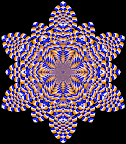Maurits Cornelis Escher (Leeuwarden, June 17, 1898 – March 27, 1972 in Laren) was a Dutch artist most known for his woodcuts, lithographs and mezzotints, which tend to feature impossible constructions, explorations of infinity, and tessellations.
Youth
Maurits Cornelis, or Mauk as he was to be nicknamed, was born in Leeuwarden (Friesland), the Netherlands. He was the youngest son of civil engineer George Arnold Escher and his second wife, Sarah Gleichman. In 1903, the family moved to Arnhem where he took carpentry and piano lessons until the age of thirteen.
From 1912 until 1918, he attended secondary school; though he excelled at drawing, his grades were generally poor, and he had to repeat the second form. Later, from 1919, Escher attended the Haarlem School of Architecture and Decorative Arts; he briefly studied architecture, but then made a switch to decorative arts, studying under Samuel Jesserun de Mesquita, an artist whom he would remain in contact with until de Mesquita, his wife and son were murdered by the Nazis in early 1944. In 1922, Escher, having gained experience in drawing and particularly woodcutting, left the school.
Marriage and later life
Escher travelled to Italy regularly in the following years. It was in Italy, too, that he first met Jetta Umiker, the same woman who he married and made his vows to in 1924. The young couple settled down in Rome after they had been married and stayed there for just over ten years until 1935; when the political climate under Mussolini became unbearable, the family moved to Château-d'Oex, Switzerland. They stayed here for two years.
Escher, however, who had been very fond of and inspired by the landscape in Italy, was decidedly unhappy in Switzerland, so two years later, in 1937, the family moved again, this time to Ukkel, a small town near Brussels, Belgium. World War II forced them to move for the last time in January 1941, this time to Baarn, the Netherlands, where Escher lived until 1970.
Most of Escher's better-known pictures date from this period; the (sometimes) cloudy, cold, wet weather of the Netherlands allowed him to focus entirely on his works, and only in 1962, when he had to undergo surgery, was there a time when no new images were created.
Escher moved to the Rosa-Spier house in Laren in the northern Netherlands in 1970, a retirement home for artists where he could have a studio of his own. He died at the home on the 27th of March 1972, he was 73 years of age. Escher and Umiker had three sons.
Works
Well known examples of his work include Drawing Hands, a work in which two hands are shown drawing each other, Sky and Water, in which plays on light and shadow convert fish in water into birds in the sky, and Ascending and Descending, in which lines of people ascend and descend stairs in an infinite loop, on a construction which is impossible to build and possible to draw only by taking advantage of quirks of perception and perspective.
Escher's work has a strong mathematical component, and many of the worlds which he drew are built around impossible objects such as the Necker cube and the Penrose triangle. Many of Escher's works employed repeated tilings called Tessellations. Escher's artwork is well-liked by scientists, especially mathematicians who enjoy his use of polyhedra and geometric distortions. For example, in Gravity, multi-colored turtles poke their heads out of a stellated dodecahedron.
One of his most notable works is the piece Metamorphosis III, which is wide enough to cover all the walls in a room, and then loop back onto itself. That was, of course, the intention.
Selected list of works
- Trees, ink, (1920)
- St. Bavo's, Haarlem, ink, (1920)
- Flor de Pascua (The Easter Flower), woodcut/book illustrations, (1921)
- Eight Heads, woodcut, (1922)
- Dolphins (Dolphins in Phosphorescent Sea), woodcut, (1923)
- Tower of Babel, woodcut, (1928)
- Landscape at Abruzzi, scratch drawing, ink and chalk, (1929)
- Street in Scanno, Abruzzi, lithograph, (1930)
- Castrovalva, lithograph, (1930)
- The Bridge, lithograph, (1930)
- Palizzi, Calabria, woodcut, (1930)
- Pentedattilo, Calabria, lithograph, (1930)
- Atrani, Coast of Amalfi, lithograph, (1931)
- Ravello and the Coast of Amalfi, lithograph, (1931)
- Covered Alley in Atrani, Coast of Amalfi, wood engraving, (1931)
- Still Life with Spherical Mirror, lithograph, (1934)
- Hand with Reflecting Sphere (Self-Portrait in Spherical Mirror), lithograph, (1935)
- Inside St. Peter's, wood engraving, (1935)
- Portrait of G.A. Escher, lithograph, (1935)
- 'Hell' , lithograph, (1935) (copied from a painting by Hieronymus Bosch)
- Regular Division of the Plane, series of drawings, (1936-196?)
- Still Life and Street, woodcut, (1937)
- Metamorphosis I, woodcut, (1937)
- Day and Night, woodcut, (1938)
- Cycle, lithograph, (1938)
- Sky and Water I, woodcut, (1938)
- Metamorphosis II, woodcut, (1939-1940)
- Verbum (Earth, Sky and Water), lithograph, (1942)
- Reptiles, lithograph, (1943)
- Ant, lithograph, (1943)
- Encounter, lithograph, (1944)
- Doric Columns, wood engraving, (1945)
- Three Spheres I, wood engraving, (1945)
- Magic Mirror, lithograph, (1946)
- Three Spheres II, lithograph, (1946)
- Another World Mezzotint (Other World Gallery), mezzotint, (1946)
- Another World (Other World), wood engraving and woodcut, (1947)
- Crystal, mezzotint, (1947)
- Up and Down, lithograph, (1947)
- Drawing Hands, lithograph, (1948)
- Dewdrop, mezzotint, (1948)
- Stars, wood engraving, (1948)
- Double Planetoid, wood engraving, (1949)
- Order and Chaos (Contrast), lithograph, (1950)
- Rippled Surface, woodcut and linoleum cut, (1950)
- Curl-up, lithograph, (1951)
- House of Stairs, lithograph, (1951)
- House of Stairs II, lithograph, (1951)
- Puddle, woodcut, (1952)
- Gravitation, lithograph and watercolor, (1952)
- Cubic Space Division, lithograph, (1952)
- Relativity, lithograph, (1953)
- Tetrahedral Planetoid, woodcut, (1954)
- Compass Rose (Order and Chaos II), lithograph, (1955)
- Convex and Concave, lithograph, (1955)
- Three Worlds, lithograph, (1955)
- Print Gallery, lithograph, (1956)
- Belvedere, lithograph, (1958)
- Sphere Spirals, woodcut, (1958)
- Ascending and Descending, lithograph, (1960)
- Waterfall, lithograph, (1961)
- Möbius Strip II (Red Ants) woodcut, (1963)
- Knot, pencil and crayon, (1966)
- Metamorphosis III, woodcut, (1967-1968)
- Snakes, woodcut, (1969)
- Matt Groening of The Simpsons made a reference to Escher in his Life in Hell comic. In Groening's parody of Escher's Relativity, cartoon rabbits fall down stairs at impossible angles. Groening would later reuse this joke in an episode of Futurama and as a couch gag on The Simpsons.
- Similarly, a character on Drawn Together, an animated series on Comedy Central, was pushed down (and up, around, and back down) a flight of stairs modeled on Relativity.
- In the Jim Henson movie Labyrinth Relativity is referenced again. The audience is again treated to an answer to the great question: what if somebody walks off the edge? The Escher estate was given acknowledgement in the credits for the film.
- The bonus stages of the first Sonic the Hedgehog game, for the Sega Genesis/Mega Drive, feature an animated background of birds turning into fish, a reference to Sky and Water.
- In Larry Niven's novel Protector, the protagonist builds a working model of Relativity using gravitational engineering.
- The Psygnosis computer game Lemmings features a level called Tribute to M.C.Escher, although it doesn't sport Escheresque graphics. The Crystal Shard computer game SubTerra features a similarly named level, which does consist entirely of a repetitive pattern.
- The early nineties rock group Chagall Guevara wrote a song called "Escher's World" which made many references to the impossible structures that can be found in Escher's work.
This article is licensed under the GNU Free Documentation License. It uses material from the Wikipedia article "M.C. Escher".









0 comments:
Post a Comment | Random Illusion